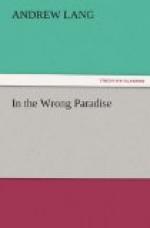The Girton girl disdained to reply to this unworthy sneer.
“I have often observed,” she said in a reflective voice, “that the most authentic and best attested bogies don’t come to very much. They appear in a desultory manner, without any context, so to speak, and, like other difficulties, require a context to clear up their meaning.”
These efforts of the Girton girl to apply the methods of philology to spectres, were received in silence. The women did not understand them, though they had a strong personal opinion about their learned author.
“The only ghost I ever came across, or, rather, came within measurable distance of, never appeared at all so far as one knew.”
“Miss Lebas has a story,” said the squire, “Won’t she tell us her story?”
The ladies murmured, “Do, please.”
“It really cannot be called a ghost-story,” remarked Miss Lebas, “it was only an uncomfortable kind of coincidence, and I never think of it without a shudder. But I know there is not any reason at all why it should make any of you shudder; so don’t be disappointed.
“It was the Long Vacation before last,” said the Girton girl, “and I went on a reading-party to Bantry Bay, with Wyndham and Toole of Somerville, and Clare of Lady Margaret’s. Leighton coached us.”
“Dear me! With all these young men, my dear?” asked the maiden aunt.
“They were all women of my year, except Miss Leighton of Newnham, who was our coach,” answered the Girton girl composedly.
“Dear me! I beg your pardon for interrupting you,” said the maiden aunt.
“Well, term-time was drawing near, and Bantry Bay was getting pretty cold, when I received an invitation from Lady Garryowen to stay with them at Dundellan on my way south. They were two very dear, old, hospitable Irish ladies, the last of their race, Lady Garryowen and her sister, Miss Patty. They were so hospitable that, though I did not know it, Dundellan was quite full when I reached it, overflowing with young people. The house has nothing very remarkable about it: a grey, plain building, with remains of the chateau about it, and a high park wall. In the garden wall there is a small round tower, just like those in the precinct wall at St. Andrews. The ground floor is not used. On the first floor there is a furnished chamber with a deep round niche, almost a separate room, like that in Queen Mary’s apartments in Holy Rood. The first floor has long been fitted up as a bedroom and dressing-room, but it had not been occupied, and a curious old spinning-wheel in the corner (which has nothing to do with my story, if you can call it a story), must have been unused since ’98, at least. I reached Dublin late—our train should have arrived at half-past six—it was ten before we toiled into the station. The Dundellan carriage was waiting for me, and, after an hour’s drive, I reached the house. The




